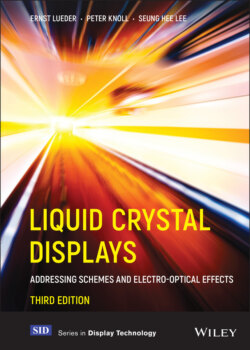Читать книгу Liquid Crystal Displays - Ernst Lueder - Страница 29
3.2.6 The HAN cell
ОглавлениеThe Hybrid Aligned Nematic cell (HAN cell) represents a mixture between the Fréedericksz cell and the DAP cell (Glueck, 1995). We investigate the reflective version in Figure 3.19(a), because among untwisted cells they have turned out to be more important. On the plate with the polarizer the LC molecules are in the field-free state in Figure 3.19(a) oriented all in the same direction parallel to the surface of the plate like in a Fréedericksz cell, whereas on the plate with the mirror they are homeotropically oriented. The linearly polarized light enters the cell at an angle α ≠ 0 to the x-axis, as in the transmissive and reflective Fréedericksz cells. The optical anisotropy Δп changes with z described by Δn(z). At z = 0 the light wave encounters the full anisotropy Δn, meaning that Δn(0) = Δn. This is only true for α ≠ 0. At z = d the light encounters no anisotropy as the medium is isotropic with a refraction index n┴, reflecting in Δn(d) = 0. Assuming a linear change of Δn(z) we obtain Δn(z) in Figure 3.19(b), leading to an effective retardation R of
(3.96)
Figure 3.19 The reflective HAN cell. (a) Cross-section; (b) optical anisotropy An(z)
We know from Equations (3.45) and (3.54) that a retardation of λ/4 transforms linearly into circularly polarized light as desired at the mirror of a reflective cell. From (1/2) Δnd = λ/4 we obtain
This is twice the thickness of the reflective Fréedericksz and DAP cells, resulting in a higher fabrication yield. This advantage of the HAN cell was brought about by lowering the effective birefringence. We shall encounter the same effect again with TN cells.
The reflection of the circularly polarized light in the field-free state is depicted in Figure 3.20(a) (Glueck, 1995). After the reflection the wave reaches the polarizer rotated by 90° and is blocked. If a field is applied in Figure 3.20(b), the molecules orient themselves due to Δε > 0 in parallel to the field, birefringence does not take place, and the reflected wave passes the polarizer. The cell is normally black.
For the homeotropic alignment of the molecules, an obliquely evaporated or sputtered SiO2 orientation layer is again a good solution.
Figure 3.20 The operation of a reflective HAN cell. (a) In the field-free state; (b) if a voltage is applied
